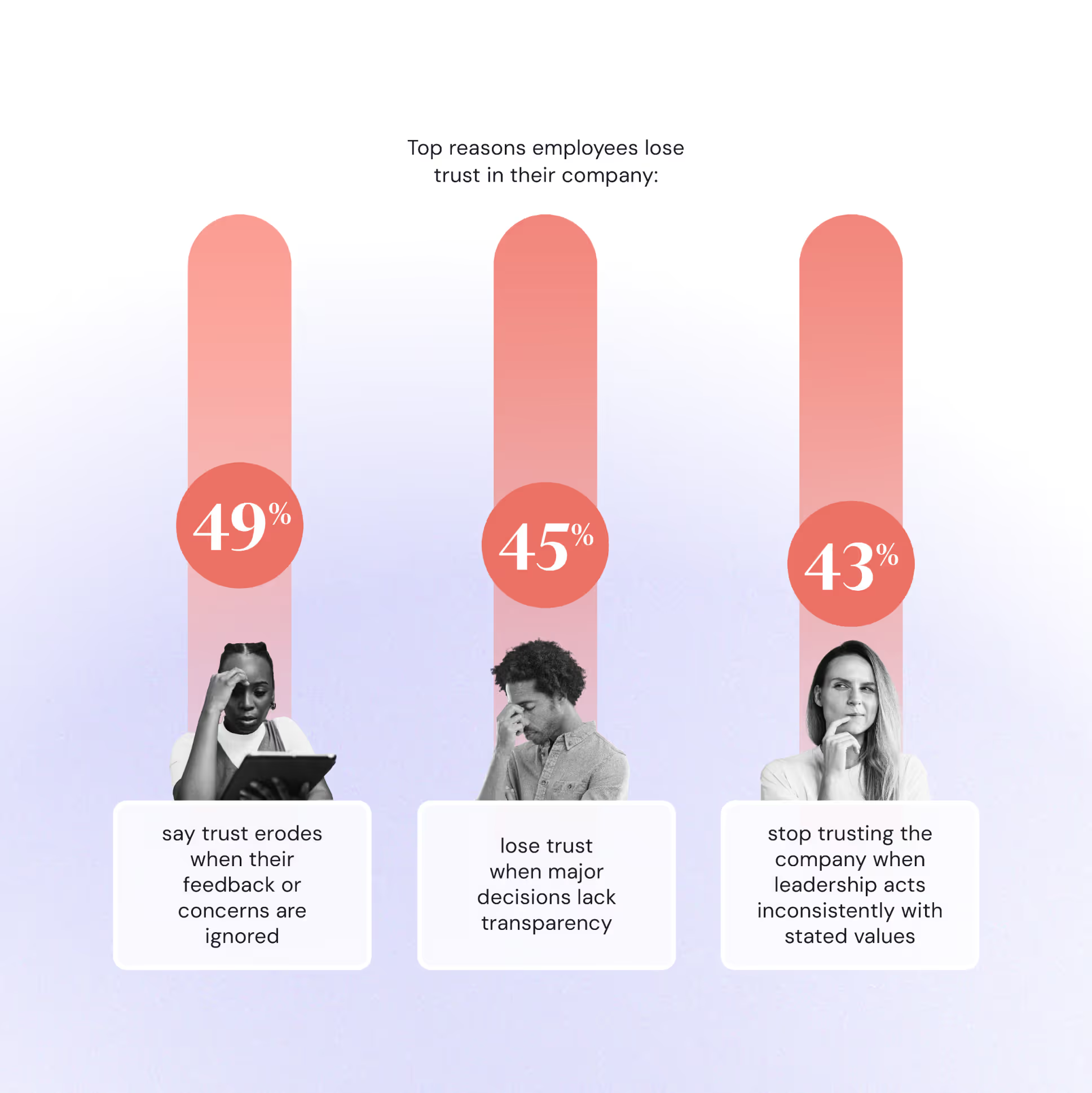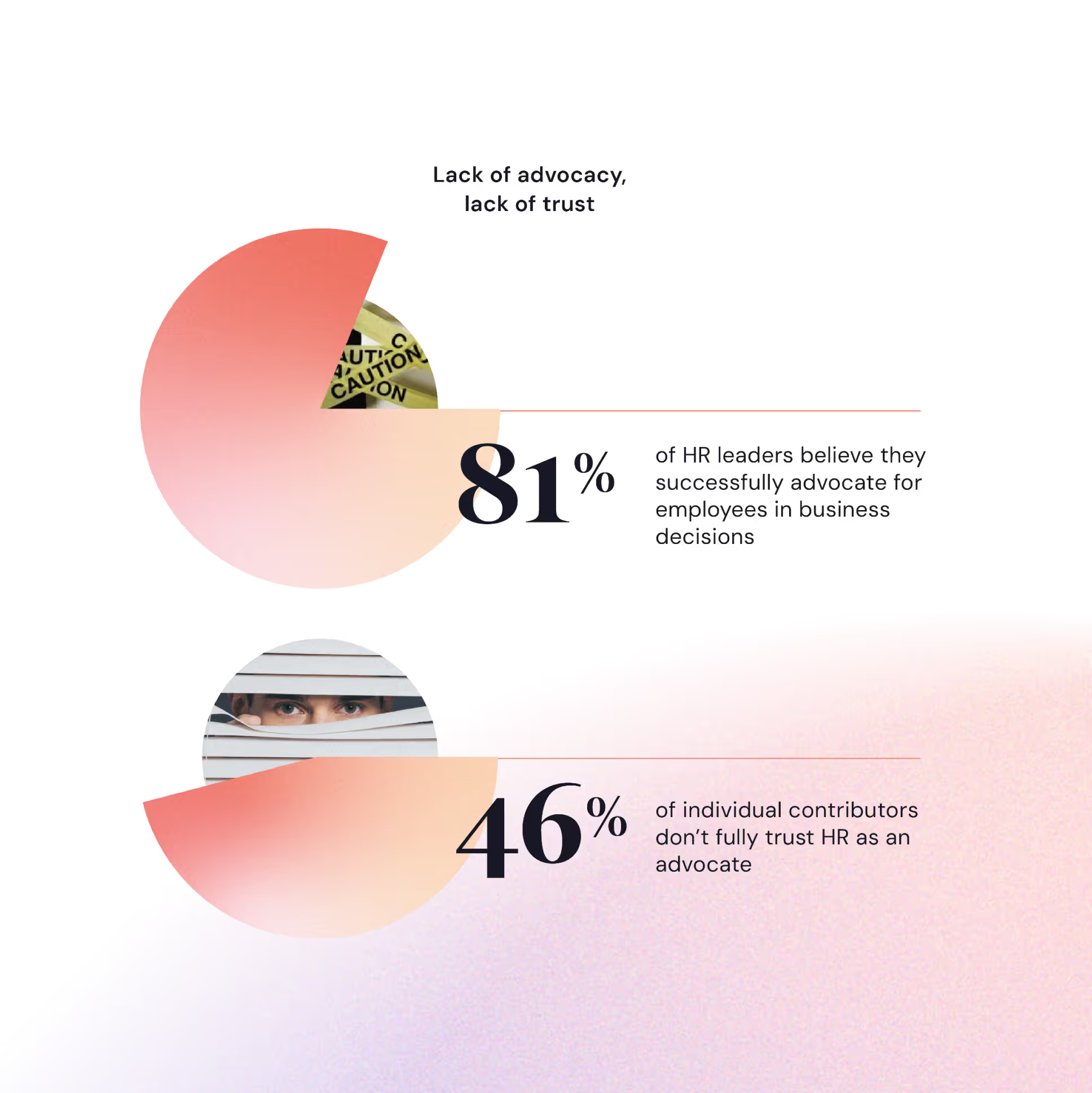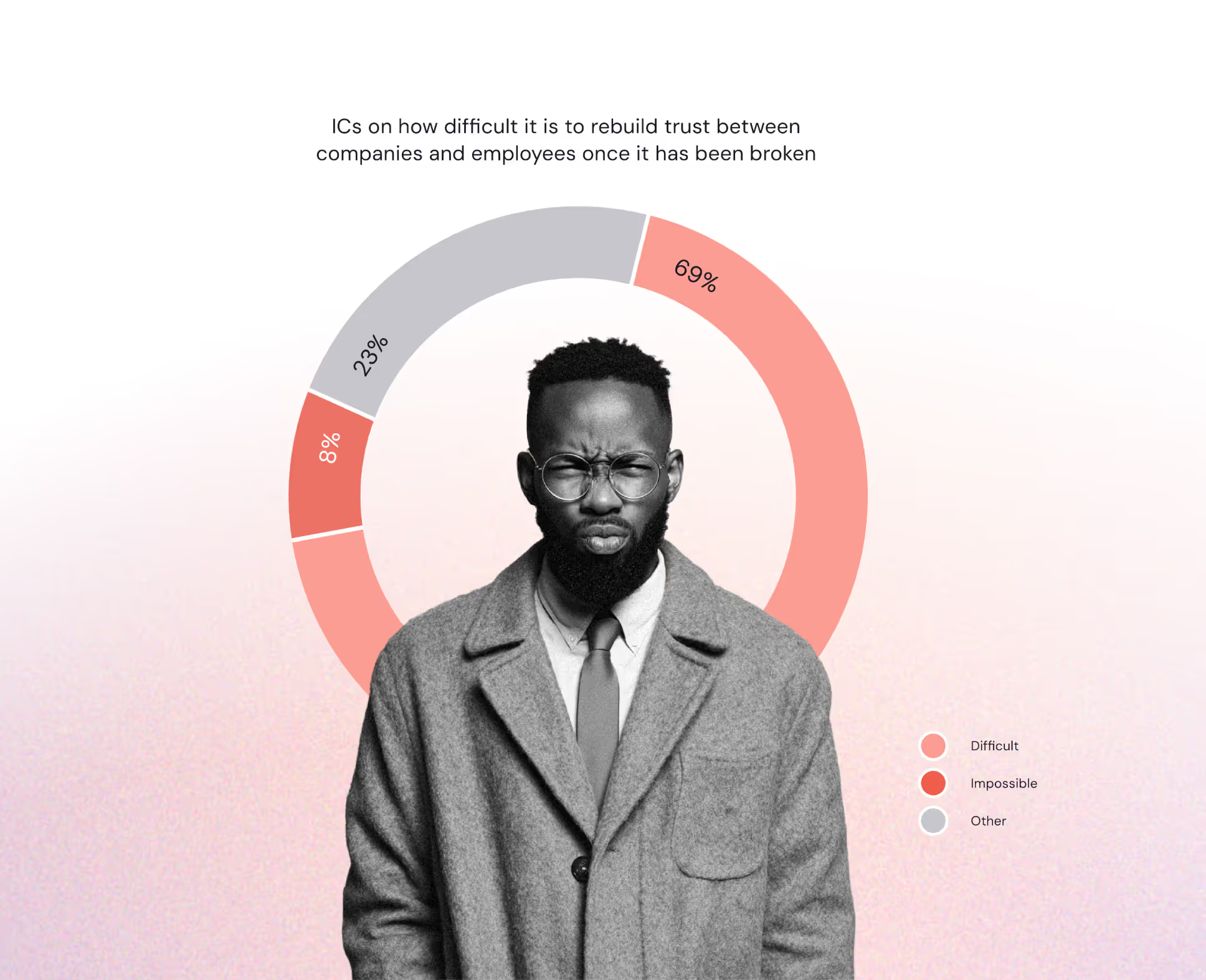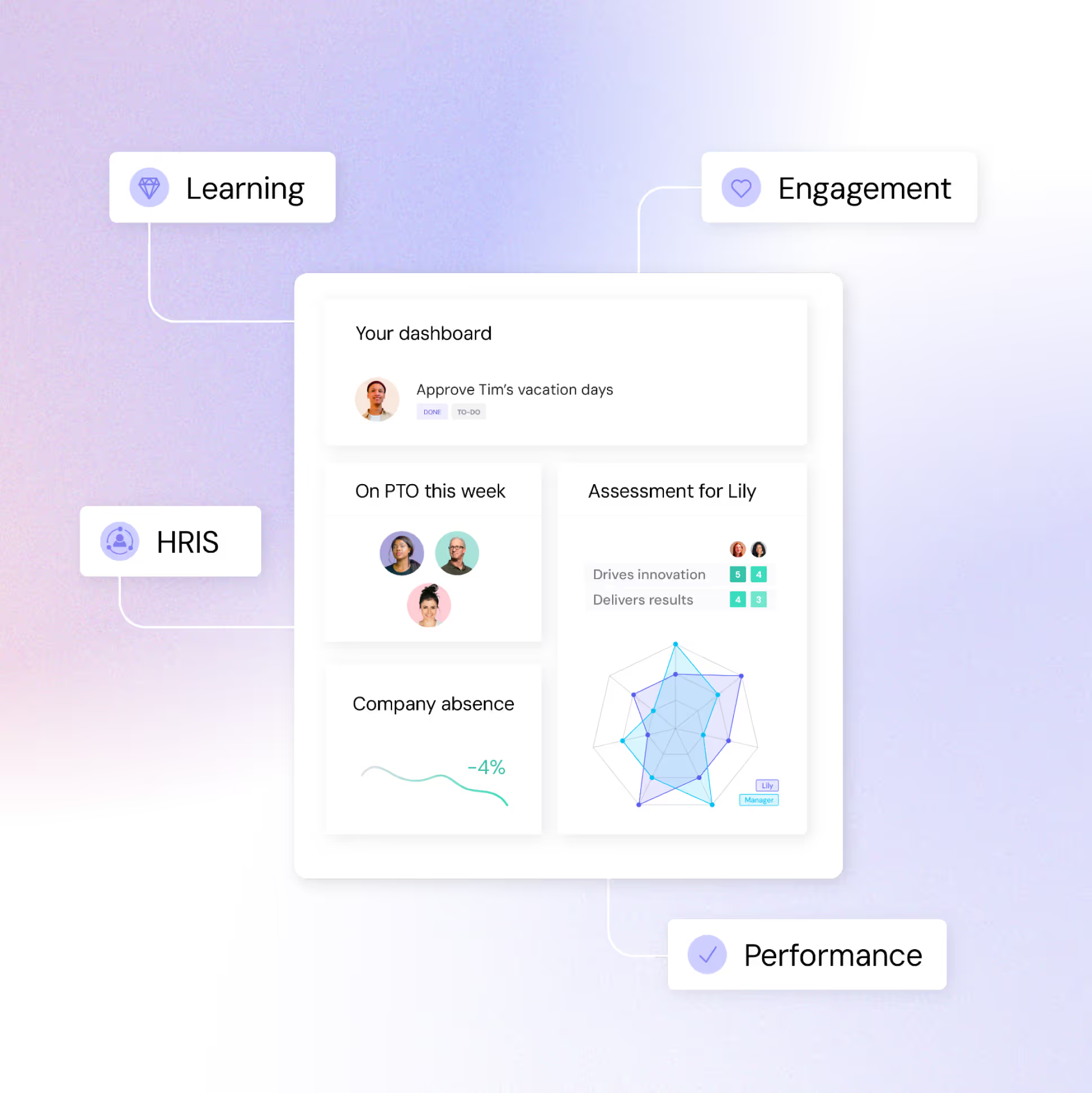2026WORKFORCE
TRENDS REPORT
Trend 4



From disconnection to direction: aligning people & business goals
HR has always been the employee’s voice in the room and the business’s voice to employees. The role is about balance: advocating for people while helping the organization succeed.
In people-centric companies, those goals often align. But when they don’t, HR has the critical job of guiding and communicating decisions in a way that still protects understanding and trust.
In recent years, tough markets, AI upheaval, and forced RTO have made that balance harder. In some companies, employees now question whether HR teams can (or will) represent both people and the business.
Loss of trust rarely comes from one policy. It builds through difficult decisions, broken promises, and changes that add pressure without enough support. When HR is seen as only carrying out leadership’s agenda, trust weakens, and even well-intentioned initiatives face skepticism.
But this dual role is also HR’s strength. With openness about why decisions are made and clarity on how they benefit employees and the organization, HR can turn challenging moments into opportunities to strengthen confidence and engagement.





Over half of employees are not convinced HR advocates for them
Even with the best intentions, HR teams often face budget constraints and operate under executive direction. When those realities aren’t visible, employees start to question: Are policies there to support people, or to push them out? Is HR a strategic partner, or simply carrying out decisions from above?
The numbers reflect this tension and underscore the need for clearer communication about how decisions are made and why.






Employees lose trust when words don’t match actions
The trust gap goes beyond HR; it shapes how employees view the entire company. Trust erodes when feedback is ignored, decisions lack explanation, or stated values aren’t applied consistently.
When this happens, employees are more likely to disengage, look for other opportunities, and share negative experiences publicly — putting retention and employer brand at risk.






Company policies are sending the wrong message
When employees already feel unsure about HR and trust is shaken, top-down policies can deepen the doubt.
Return-to-office rules and budget cuts shape how employees read the company’s priorities. When those choices suggest control is valued more than care, trust erodes and people start to question their future with the organization.






Executive tensions leave employees feeling unprotected
As trust wears down, perception matters more than intent.
HR may take part in leadership debates, but when decisions arrive without context, employees rarely see the pushback — only the enforcement. That absence fuels doubt about HR’s authority and leaves people feeling unprotected.






Advocacy only builds trust if employees can see it
Most HR leaders believe they advocate for employees in critical decisions. Employees are less certain: fewer than half fully trust HR to play that role, with many neutral or unconvinced.
Without visible evidence of advocacy, uncertainty grows and trust weakens.






Employees say rebuilding trust won’t be easy
Trust doesn’t bounce back on its own. Most employees believe it’s difficult to repair, but very few think it’s impossible. That distinction matters: it shows change is still possible — but only if leaders take visible, consistent action.






Turn insights into action
Rebuild trust by explaining the “why,” bringing employees into decisions, and closing the loop so people can see how their input shaped the outcome.
Bring employee voices into decisions
Involve employees in discussions that affect their work, and make clear how their input influenced the final call.
Shift from gatekeepers to enablers
Remove barriers, back employee-led improvements, and support changes that strengthen culture and day-to-day work.
Prove trust is worth rebuilding
Share the steps you’re taking to repair it, then follow through. Consistent, visible action — even in small wins — shows that change is real.




How to foster trust & engagement in a lean, high‑performing, high‑stakes environment
After several years of an employee-driven market, the tide has shifted. Tech is no longer the perk-filled darling employer it once was. Instead, the industry is spending billions on replacing human workers. The rise (and fear) of AI-driven layoffs is real, and we're watching entry-level roles disappear against the backdrop of a tense global political and economic climate.
Applications are up, but outcomes aren’t. 37% of professionals say they’re applying to more jobs than ever — but hearing back less.* At Proton, applications per opening have risen 30% year over year. While that gives us more control over headcount and compensation, the drop in external mobility can quickly lead to disengagement and lower performance.
Here’s how I foster trust and engagement in uncertain times:
1. Lead through authenticity and clarity, even when it’s uncomfortable
Trust doesn’t come from perfect conditions: it comes from truth-telling. We need to be candid about business challenges, market shifts, and expectations. The goal isn’t to spread fear, but to remove ambiguity. Employees handle bad news better than they handle “spin.”
2. Make clarity the new kindness
Lack of clarity kills productivity. High-performing teams crave clear goals, feedback, and career trajectories — even if the message is “Your promotion path may take longer” or "Salary increases won’t happen every year." Being upfront prevents resentment and rumor mills from taking over.
3. Redefine engagement as belonging and purpose
Flashy perks can’t replace meaning. What keeps people is a team they’re proud of, a mission that feels relevant, and a place where their voice matters. We make this real by tying team goals to company mission and regularly spotlighting recognition.
In the end, the goal isn’t to convince people they’re lucky to have a job, but to help them see that their contributions matter. Treat employees like placeholders, and they’ll act like it. Treat them like they’re building something meaningful (even in a rough season) and they’ll rise to that belief.
*Source: LinkedIn Work Change Report 2025





A framework for rebuilding confidence
One way to think about this challenge is through the CHARGE® model, which highlights six traits HR leaders can lean on:
Courage — name disruptions openly rather than downplaying them.
Humility — listen, co-create, and acknowledge when things need to change.
Accuracy — provide clarity on priorities, expectations, and decisions.
Resiliency — pace change and protect energy, rather than pushing harder.
Goal-oriented — connect organizational outcomes with personal impact.
Exemplary — model the same standards and behaviors expected of others.These aren’t abstract ideals — they’re practical traits HR leaders can use to rebuild trust and strengthen credibility in the year ahead.
Read more about the CHARGE® model in Keri’s book The Way of the HR Warrior





Setting sights on 2026
This year’s trends point to one story: the pace of change is accelerating, and employees can’t navigate it alone. HR is the function best positioned to guide that transition — connecting people’s needs with the organization’s goals, and making change feel both manageable and meaningful.
Many want to grow but feel stuck in roles that no longer fit. AI is reshaping work faster than companies can adapt, piling pressure onto leaner teams. And while HR leaders are asked to manage cost and complexity, trust slips when decisions arrive without explanation or follow-through.
The good news is that each of these challenges can be addressed with the same foundation: listen closely, act on what you hear, and build systems that put people at the center of change.
In practice, it means:
- Helping employees see a path forward with meaningful growth opportunities and support
- Introducing AI with integrity, defined ownership, and training that builds confidence
- Communicating tough decisions with transparency, explaining trade-offs and committing to next steps
With the right approach and tools, HR can guide organizations through disruption with purpose. In moments of complexity, People teams can build alignment. When change accelerates, they can ensure progress is sustainable and doesn’t come at the expense of people.





Sample
Survey of 2,400 full-time professionals (30+ hours/week)
- Roles: managers (1,034), individual contributors (566), and HR leaders (800)
- Company size: 50–2,500 employees
- Industries: tech, consulting, marketing, advertising, PR, market research, IT/computing, business services, media
- Locations: US, UK, Germany, Netherlands
Methodology
- 15-min online survey
- Responses collected between June 21 and July 2, 2025
Findings are directional and reflect trends across our sample. Individual organizations may face different conditions depending on their structure, culture, and context.






How Leapsome can support you in 2026
Leapsome unifies HRIS, performance, and engagement in one AI-enabled platform.
We lighten the admin load so HR teams can focus on building trust, supporting growth, and driving impact with their people.




-compressed.avif)
